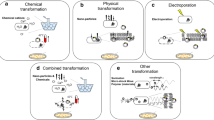Summary
HgCl2 resistance (Hgr) in a strain of Pseudomonas putrefaciens isolated from the River Mersey was identified as plasmid-borne by its transfer to Escherichia coli in conjugative matings. This plasmid, pMERPH, could not be isolated and was incompatible with the chromosomally integrated IncJ Hgr plasmid R391. pMERPH and R391 both express inducible, narrow-spectrum mercury resistance and detoxify HgCl2 by volatilization. The cloned mer determinants from pMERPH (pSP100) and R391 (pSP200) have very similar restriction maps and express identical polypeptide products. However, these features show distinct differences from those of the Tn501 family of mer determinants. pSP100 and pSP200 failed to hybridize at moderate stringency to merRTPA and merC probes from Tn501 and Tn21, respectively. We conclude that the IncJ mer determinants are only distantly related to that from Tn501 and its closely homologous relatives and that it identifies a novel sequence which is relatively rare in bacteria isolated from natural environments.
Similar content being viewed by others
References
Barrineau P, Gilbert P, Jackson WJ, Jones SC, Summers AO, Wisdom S (1984) The DNA sequence of the mercury resistance operon of the incFII plasmid NR1. J Mol Appl Genet 2:601–619
Birnboim HC, Doly J (1979) A rapid alkaline extraction procedure for screening recombinant plasmid DNA. Nucleic Acids Res 7:1513–1523
Brown NL, Ford SJ, Pridmore RD, Fritzinger DC (1983) Nucleotide sequence of a gene from the Pseudomonas transposon Tn501 encoding mercuric reductase. Biochemistry 22:4089–4098
Brown NL, Lund PA, Ni'Bhriain N (1989) Mercury resistance in bacteria. In: Hopwood DA, Chater KF (eds) Genetics of bacterial diversity. Academic Press, London, pp 175–195
Chang ACY, Cohen SN (1978) Construction and characterization of amplifiable multicopy DNA cloning vehicles derived from the P15A cryptic miniplasmid. J Bacteriol 134:1141–1156
Coetzee JN, Datta N, Hedges RW (1972) R factors from Proteus rettgeri. J Gen Microbiol 72:543–552
de Bruijin FJ, Lupski JR (1984) The use of transposon Tn5 mutagenesis in the rapid generation of correlated physical and genetic maps of DNA segments cloned into multicopy plasmids — a review. Gene 27:131–149
Eckhardt T (1978) A rapid method for the identification of plasmid DNA in bacteria. Plasmid 1:584–588
Feinberg AP, Vogelstein B (1984) A technique for radiolabelling DNA restriction endonuclease fragments to high specific activity. Anal Biochem 137:266–267
Foster TJ (1983) Plasmid-determined resistance to antimicrobial drugs and toxic metal ions in bacteria. Microbiol Rev 47:361–409
Foster TJ (1987) The genetics and biochemistry of mercury resistance. CRC Crit Rev Microbiol 15:117–140
Foster TJ, Ginnity F (1985) Some mercurial resistance plasmids from different incompatibility groups that both repress and induce the mer operon of R100. J Bacteriol 162:773–776
Griffin H, Foster TJ, Silver S, Misra TK (1987) Cloning and DNA sequence analysis of the mercuric and organomercurial resistance determinants of plasmid pDU1358. Proc Natl Acad Sci USA 84:3112–3116
Jobling MG, Ritchie DA (1987) Genetic and physical analysis of plasmid genes expressing inducible resistance to tellurite in E. coli. Mol Gen Genet 208:288–293
Jobling MG, Peters SE, Ritchie DA (1988a) Plasmid-borne mercury resistance in aquatic bacteria. FEMS Microbiol Lett 49:31–37
Jobling MG, Peters SE, Ritchie DA (1988b) Restriction pattern and polypeptide homology among plasmid-borne mercury resistance determinants. Plasmid 20:106–112
Kado CI, Liu ST (1981) Rapid procedure for detection and isolation of large and small plasmids. J Bacteriol 145:1365–1373
Laddaga RA, Chu L, Misra TK, Silver S (1987) Nucleotide sequence and expression of the mercurial resistance operon from Staphylococcus aureus plasmid p1258. Proc Natl Acad Sci USA 84:5106–5110
Maniatis T, Fritsch EF, Sambrook J (1982) Molecular cloning: A laboratory manual. Cold Spring Harbour Laboratory, Cold Spring Harbor, NY
Miller JH (1972) Experiments in microbial genetics. Cold Spring Harbour Laboratory, Cold Spring Harbor, NY
Misra TK, Brown NL, Fritzinger DC, Pridmore RD, Barnes WM, Haberstroh L, Silver S (1984) The mercuric-ion resistance operons of plasmid R100 and transposon Tn501: the beginning of the operon including the regulatory region and the first two structural genes. Proc Natl Acad Sci USA 81:5975–5979
Nakahara H, Ishikawa T, Sarai Y, Kondo I (1977) Frequency of heavy-metal resistance in bacteria from inpatients in Japan. Nature 266:165–167
NiBhriain NN, Silver S, Foster TJ (1983) Tn5 insertion mutations in the mercuric ion resistance genes derived from plasmid R100. J Bacteriol 155:690–703
Nugent ME (1981) A conjugative ‘plasmid’ lacking autonomous replication. J Gen Microbiol 126:305–310
O'Connor CD, Humphreys GO (1982) Expression of the EcoRI restriction-modification system and the development of positive selection vectors. Gene 20:219–229
Pembroke JT, Stevens E (1984) The effect of plasmid R391 and other incJ plasmids on the survival of Escherichia coli after u.v. irradiation. J Gen Microbiol 130:1838–1844
Peters SE (1988) Mercury resistance plasmids in aquatic bacteria. PhD Thesis, University of Liverpool, UK
Rigby PWJ, Diekmann M, Rhodes C, Berg P (1977) Labelling DNA to high specific activity in vitro by nick-translation with DNA polymerase I. J Mol Biol 113:237–251
Sancar A, Hack AM, Rupp WD (1979) Simple method for identification of plasmid-encoded proteins. J Bacteriol 137:692–693
Schottel J, Mandal A, Clark D, Silver S (1974) Volatilization of mercury and organomercurials determined by inducible R-factor systems in enteric bacteria. Nature 251:335–337
Stanisich VA, Arwas R, Bennet PM, de la Cruz F (1989) Characterization of Pseudomonas mercury-resistance transposon Tn502, which has a preferred insertion site in RP1. J Gen Microbiol 135:2909–2915
Strike P, Lodwick D (1987) Plasmid genes affecting DNA repair and mutation. J Cell Sci (Suppl 6):303–321
Twigg AJ, Sherratt D (1980) Transcomplementable copy number mutants of plasmid ColEI. Nature 283:216–218
Author information
Authors and Affiliations
Additional information
Communicated by W. Goebel
Rights and permissions
About this article
Cite this article
Peters, S.E., Hobman, J.L., Strike, P. et al. Novel mercury resistance determinants carried by IncJ plasmids pMERPH and R391. Molec. Gen. Genet. 228, 294–299 (1991). https://doi.org/10.1007/BF00282479
Received:
Issue Date:
DOI: https://doi.org/10.1007/BF00282479




